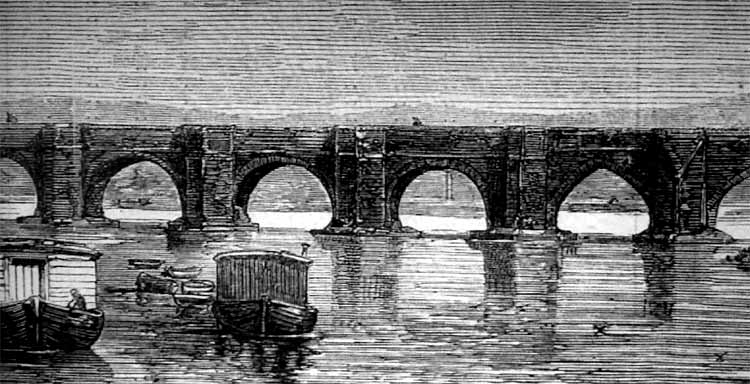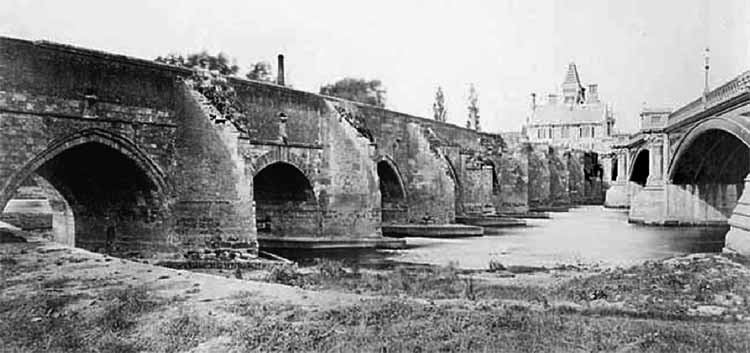Articles from the Thoroton Society Newsletter
Hethbeth Bridge
 The Hethbeth Bridge as drawn in 1871, reproduced from the Illustrated London News (5 August 1871).
The Hethbeth Bridge as drawn in 1871, reproduced from the Illustrated London News (5 August 1871).In July 2021, the Trent Bridge celebrated its 150th anniversary. Throughout its existence, it has been a vital means of crossing the river, with tens of thousands of vehicles and many pedestrians passing over the bridge each day by February 2020, according to a study. A river crossing has, however, been necessary for Nottingham since the early medieval period, so what came before this iconic bridge?
The Anglo-Saxon Chronicle records that in the year 923 or 924, King Edward the Elder ordered a new stronghold to be established on the southern side of the River Trent, and that a bridge be built to connect that stronghold with the burh of Snotingeham. It is widely believed that this was the bridge later known as the Hethbeth Bridge (the immediate forerunner of the Trent Bridge), although it has also been suggested that the southern stronghold may have been Wilford and that the early 10th century bridge was therefore further to the west.
Certainly, by the Norman Conquest there was a bridge connecting West Bridgford and Nottingham, and this formed the main access route from the south. It was a vitally important means by which goods and people could be brought to and from the town, and it connected the North and South of England. After crossing the Trent, people would make their way over the causeway which was raised above the often-flooded Meadows and would then cross the River Leen, entering the town near Narrow Marsh and Fisher Gate.
By the early 13th century, St John’s Hospital was entrusted with the upkeep of the bridge but by the early 14th century the responsibility was given to individuals such as John and Alice Palmer. A succession of kings took great interest in the bridge’s condition, with a number of Royal inquisitions set up to ensure it was rebuilt. The bridge was originally constructed of timber, probably on stone piers. Records indicate that stone was quarried for the bridge in 1234, but large parts of its structure remained of timber throughout the medieval period, during which it was often described as being in a ruinous condition, in need of rebuilding. According to records, as well as a description by the antiquarian Charles Deering, the bridge was still partly made of timber in 1683 when it was largely destroyed, having also been damaged during Civil War skirmishes. In 1683 rebuilding works led to the bridge becoming a 20-arch bridge, built entirely of stone. However, photographs and illustrations of the bridge show at least two distinct phases of construction, with the southern arches of the bridge appearing to be of a late medieval form.
There was a chapel on the bridge, which enabled travellers to say a prayer as they crossed, and this was also used as a means to collect alms for the upkeep of the bridge. The earliest reference to a chapel dates to 1301/2 when it was dedicated to St Mary, but a rebuilding of the bridge before 1322 led to a new chapel, dedicated to St James, being built. A chantry certificate of the 1540s referred to Launcelett Wodhall as being the 'chaunterie preste' and described a 'chappell covered with leade, with an alter [sic] to celebrate, upon the bridge of Nottingham...'. In 1817, 1826 and 1831, during repairs to foundations of the bridge and during periods of low water level, substantial amounts of stonework were found on the riverbed, including sculptured stone and mullioned windows resembling those at St Mary's Church. The stone was found close to the 6th and 7th arches of the bridge, and it was suggested that was where the chapel may have stood.
Due to the increased volume of traffic, it was decided in 1868 that a new bridge was needed and so the extant Trent Bridge was built in 1871.
 The Hethbeth Bridge and New Trent Bridge photographed in 1871.
The Hethbeth Bridge and New Trent Bridge photographed in 1871.It stood adjacent to the Hethbeth Bridge and, for a few months these bridges co-existed, before Hethbeth was demolished later that year. A short length of the bridge survives just outside the City Council boundary, at West Bridgford, close to County Hall, and this is preserved as a Scheduled Monument meaning that it is legally protected and deemed to be of national significance. It is believed that these remains are of late medieval date, although they have yet to be dated more closely than this broad period.During the excavations for the bridge’s foundations in 1871, remains of what was believed to be a landing stage were encountered. It was formed of black oak beams trenailed together with oak pins, cross braced framing, all resting on large blocks of an unidentified type of stone.
Scott Lomax, City Archaeologist
< Previous